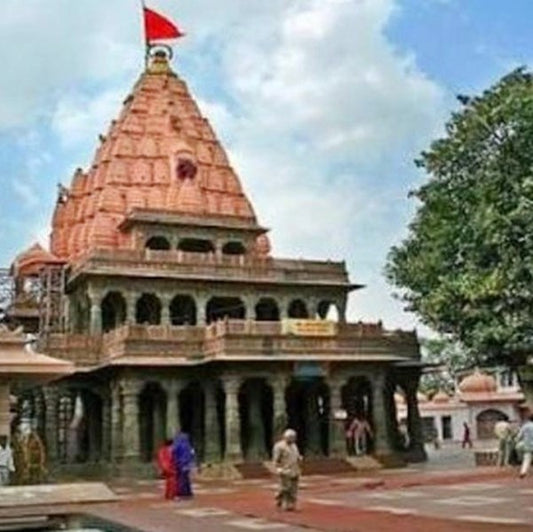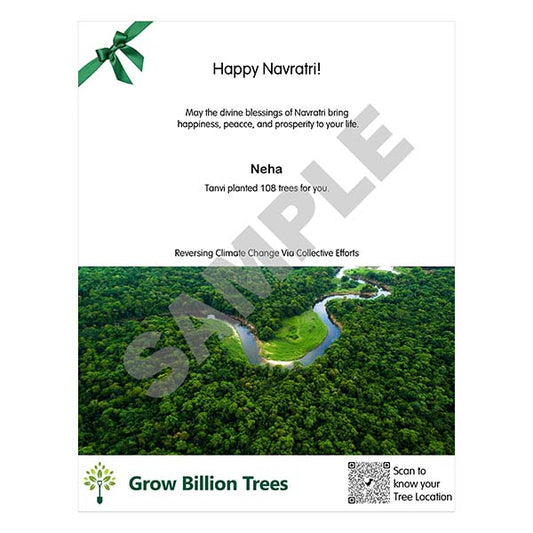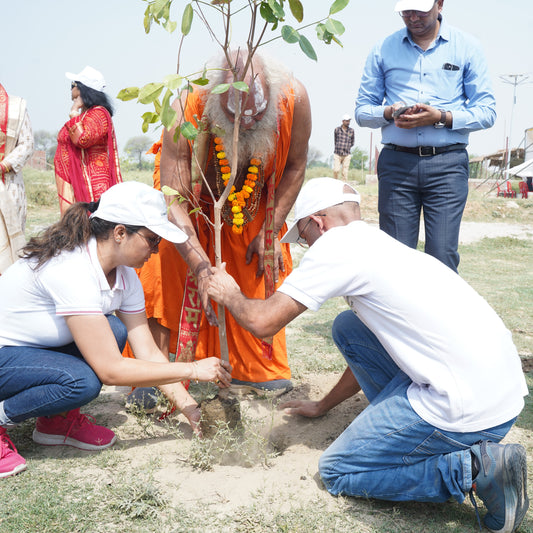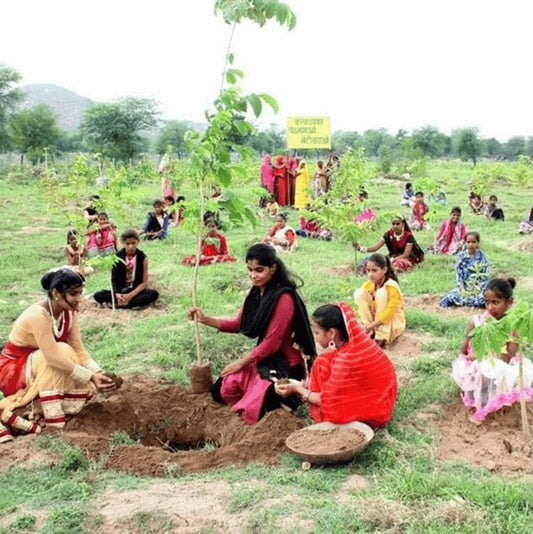Celebrate Navratri with Trees
Planting trees during Navratri is a meaningful way to honor the divine feminine energy celebrated during this time. The festival is dedicated to the w Read more
-
Trees for Navratri
Regular price ₹ 299Regular priceUnit price per -
Trees for Gudi Padwa
Regular price ₹ 299Regular priceUnit price per -
Trees for Ugadi
Regular price ₹ 299Regular priceUnit price per -
 Project Closed
Project ClosedTrees for Navratri near Mahakal Ujjain
Regular price ₹ 501Regular priceUnit price per -
Trees for Kanya Pujan on Navratri
Regular price ₹ 299Regular priceUnit price per -
 Project Closed
Project ClosedTrees for Navratri near Ram Mandir Ayodhya Ji
Regular price ₹ 501Regular priceUnit price per -
 Project Closed
Project ClosedTrees for Ram Navmi near Ram Mandir Ayodhya Ji
Regular price ₹ 501Regular priceUnit price per
Celebrate Navratri with Trees
Planting trees during Navratri is a meaningful way to honor the divine feminine energy celebrated during this time. The festival is dedicated to the worship of various forms of the Goddess, who is often associated with nature and fertility.
By planting trees, we can show gratitude for the abundance and blessings of the natural world and pay homage to the divine feminine. Nurturing and caring for a new sapling reflects the nurturing qualities of the Goddess.
In Hindu mythology, all nine forms of Durga, the goddess of power and strength, are associated with different aspects of nature. However, the form of Durga known as Maa Prakriti or Shailputri is specifically associated with nature. She is worshipped on the first day of Navratri and is believed to represent the earth and the natural world. Her name, Shailputri, literally means "daughter of the mountains".
Navratri tree planting
Planting trees during Navratri is a great way to celebrate the festival while also promoting sustainability and environmental consciousness.
Eco
Emphasizing eco friendly practices during Navratri can include planting trees, reducing waste, and promoting sustainable practices.
Navratri green initiatives
Encouraging green initiatives during Navratri can include planting trees, using eco friendly products, and reducing carbon footprint.
Navratri tree plantation campaign
Creating a tree plantation campaign during Navratri can help promote environmental awareness and create a positive impact.
Tree planting for Navratri
Encouraging tree planting during Navratri can create a positive impact on the environment and promote ecofriendliness.
Navratri sustainability
Promoting sustainability during Navratri can include tree planting, reducing waste, and using eco-friendly products.
Green Navratri celebrations
Celebrating Navratri in an environmentally friendly manner can include tree planting and promoting sustainable practices.
Navratri eco initiatives
Encouraging eco initiatives during Navratri can include tree planting, reducing carbon footprint, and using renewable energy sources.
Navratri green movement
Joining the green movement during Navratri can include tree planting and promoting environmental consciousness.
Navratri tree donation
Donating trees during Navratri can create a positive impact on the environment and promote eco-friendliness.
Tree plantation drive for Navratri
Organizing a tree plantation drive during Navratri can create a positive impact on the environment and promote sustainability.
Navratri green revolution
Joining the green revolution during Navratri can include tree planting and promoting eco friendly practices.
Navratri green pledge
Taking a green pledge during Navratri can include tree planting and promoting sustainable practices.
Navratri eco celebrations
Celebrating Navratri in an environmentally friendly manner can include tree planting and reducing carbon footprint.
Navratri green awareness
Promoting green awareness during Navratri can include tree planting and educating others about sustainable practices.
Navratri tree plantation event
Hosting a tree plantation event during Navratri can create a positive impact on the environment and promote eco-friendliness.
Navratri environmental initiatives
Encouraging environmental initiatives during Navratri can include tree planting, reducing waste, and promoting sustainable practices.
Navratri green festival
Celebrating Navratri as a green festival can include tree planting and promoting eco-friendly practices.
Navratri tree sapling distribution
Distributing tree saplings during Navratri can promote environmental awareness and create a positive impact on the environment.
Navratri green community
Creating a green community during Navratri can include tree planting and promoting sustainable practices to create a positive impact on the environment.
Browse Trees Plantations
FAQ
What is Navratri?
Navratri is a Hindu festival that is celebrated for nine nights and ten days in honor of the divine feminine goddess, Durga. It typically takes place in the Hindu month of Ashwin (September-October), although there is also another Navratri that occurs in the month of Chaitra (March-April). The word Navratri literally means "nine nights" in Sanskrit, and it symbolizes the triumph of good over evil. During Navratri, devotees worship the nine forms of Goddess Durga, known as Navadurga. Each day of Navratri is dedicated to one of these forms of the goddess, and devotees offer prayers, perform special rituals, and fast during this period.
Why are trees planted during Navratri?
Trees are planted during Navratri as a way to honor and celebrate nature, which is seen as a manifestation of the divine feminine energy.
What is the relation between Shailputri and tree plantation?
In Hindu mythology, all nine forms of Durga, the goddess of power and strength, are associated with different aspects of nature. However, the form of Durga known as Maa Prakriti or Shailputri is specifically associated with nature. She is the first form of Durga and is depicted as a young woman holding a trident and riding a bull. She is worshipped on the first day of Navratri and is believed to represent the earth and the natural world. Her name, Shailputri, literally means "daughter of the mountains,"
What types of trees are planted during Navratri?
The types of trees planted during Navratri depend on the region and tradition. Common trees include neem, mango, peepal, and banyan.
What is the significance of neem trees during Navratri?
Neem trees are considered sacred during Navratri because they are believed to have medicinal and purifying properties. They are also associated with the goddess Durga.
What is the significance of mango trees during Navratri?
Mango trees are associated with the goddess Lakshmi and are planted during Navratri as a symbol of abundance and prosperity.
What is the significance of peepal trees during Navratri?
Peepal trees are considered sacred in Hinduism and are associated with the god Vishnu. They are planted during Navratri as a way to honor the divine.
What is the significance of banyan trees during Navratri?
Banyan trees are associated with the goddess Kali and are planted during Navratri as a symbol of strength and longevity.
Where are trees planted during Navratri?
Trees are planted in various locations during Navratri, including temples, public spaces, and private residences.
How are trees planted during Navratri?
Trees are typically planted with a ceremony that involves prayer and offerings to the gods and goddesses.
What are some benefits of planting trees during Navratri?
Benefits of planting trees during Navratri include improving air and water quality, providing shade, and supporting biodiversity.
How can I get involved in tree planting during Navratri?
You can get involved in tree planting during Navratri by joining a local community group or temple
Why is giving trees as a gift a good idea?
Giving trees as a gift is a good idea because trees provide a long-lasting and meaningful present that symbolizes growth, life, and sustainability.
Can I personalize the tree?
Yes, you can personalize the gift of a tree via a certificate and a personalized greeting card with the gift.
Can I choose where the tree is planted?
No, tree plantation happens in bulk in forest with capacity of 10,000 or more plants. location is chosen based availability.
How can giving trees as gifts be environmentally friendly?
Giving trees as gifts can be environmentally friendly because trees provide numerous benefits, such as absorbing carbon dioxide, improving air and water quality, and providing habitats for wildlife.
How much does it cost to give a tree as a gift?
The cost of giving a tree as a gift start at Rs 99. It can vary depending on the tree species, size, and where it is located.






















